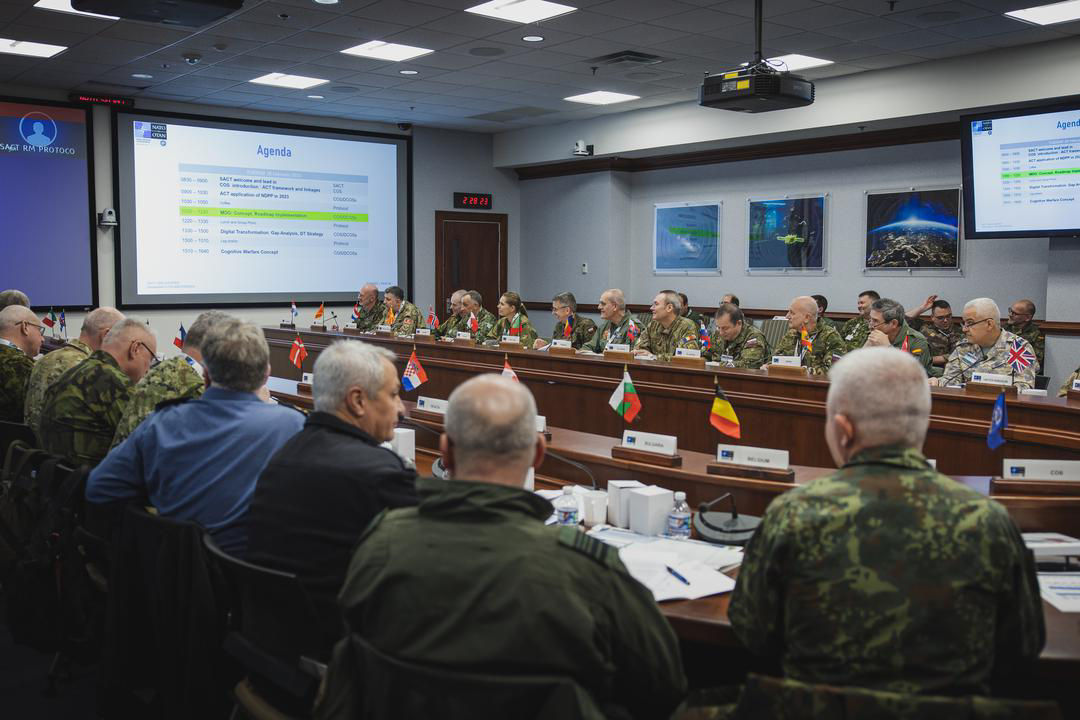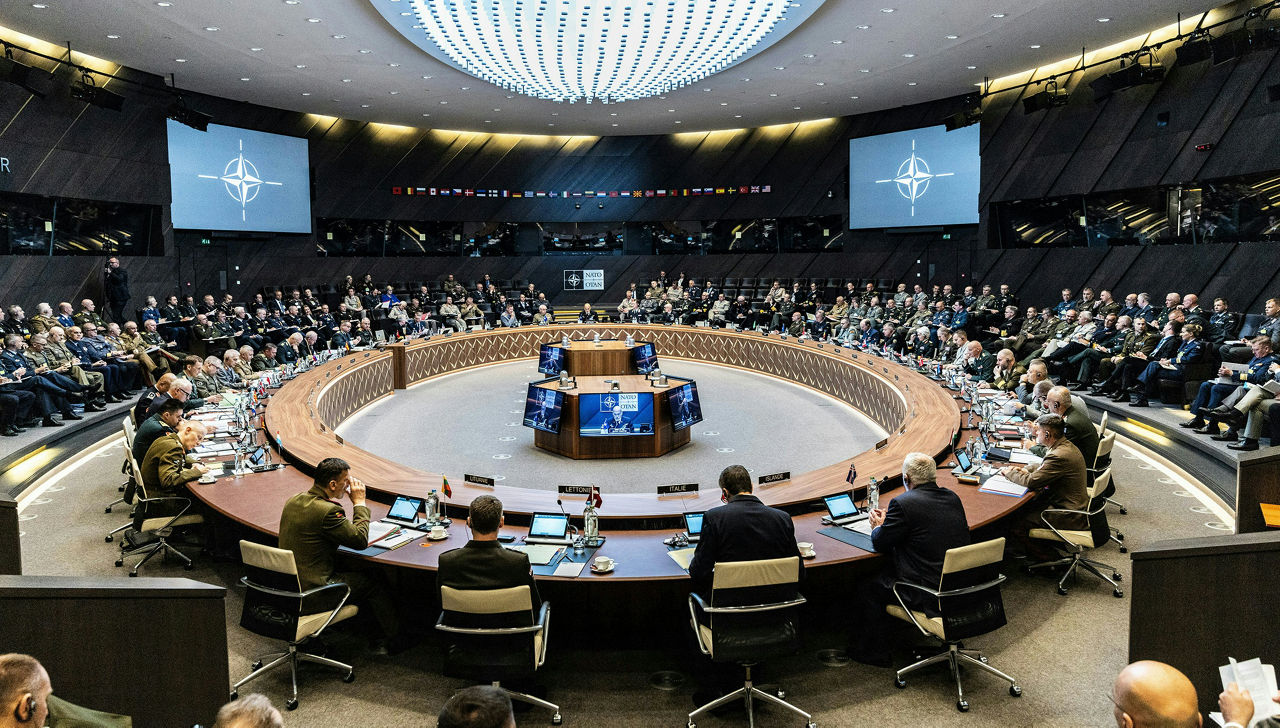Download NATO’s broadcast-quality video content free of charge

Log in
NATO MULTIMEDIA ACCOUNT
Access NATO’s broadcast-quality video content free of charge

Check your inbox and enter verification code
You have successfully created your account
From now on you can download videos from our website
Subscribe to our newsletter
If you would also like to subscribe to the newsletter and receive our latest updates, click on the button below.
Enter the email address you registered with and we will send you a code to reset your password.
Didn't receive a code? Send new Code
The password must be at least 12 characters long, no spaces, include upper/lowercase letters, numbers and symbols.
Your password has been updated
Click the button to return to the page you were on and log in with your new password.
Military Committee
Updated: 17 January 2025
The Military Committee (MC) is the senior military authority in NATO and the oldest permanent body in NATO after the North Atlantic Council, both having been formed only months after the Alliance came into being. It is the primary source of military advice to the North Atlantic Council and the Nuclear Planning Group, and gives direction to the two Strategic Commanders.
- The Military Committee is the primary source of consensus-based advice to the North Atlantic Council and the Nuclear Planning Group on military policy and strategy, and it provides guidance to the two Strategic Commanders – Supreme Allied Commander Europe and Supreme Allied Commander Transformation.
- As such, it is an essential link between the political decision-making process and the military structure of NATO.
- The Military Committee is responsible for translating political decision and guidance into military direction, and for recommending measures considered necessary for the defence of the NATO area and the implementation of decisions regarding military operations.
- It also develops strategic policy and concepts, and prepares an annual long-term assessment of the strength and capabilities of countries and areas posing a risk to NATO's interests.
- The Military Committee, headed by its Chair, meets frequently at the level of national Military Representatives, and three times a year at the level of Chiefs of Defence.
Roles and responsibilities
Consensus-based advice on military matters
The Committee’s principal role is to provide consensus-based advice on military policy and strategy to the North Atlantic Council and direction to NATO’s Strategic Commanders. It is responsible for recommending to NATO's political authorities those measures considered necessary for the common defence of the NATO area and for the implementation of decisions regarding NATO’s operations and missions.
The Military Committee’s advice is sought as a matter of course prior to authorisation by the North Atlantic Council of NATO military activities or operations.
It represents an essential link between the political decision-making process and the military command structure of NATO and is an integral part of the decision-making process of the Alliance.
Strategic direction
The Military Committee also plays a key role in the development of NATO’s military policy and doctrine within the framework of discussions in the Council, the Nuclear Planning Group and other senior bodies. It is responsible for translating political decision and guidance into military direction to NATO’s two Strategic Commanders – Supreme Allied Commander Europe and Supreme Allied Commander Transformation.
In this context, the Committee assists in developing overall strategic concepts for the Alliance and prepares an annual long-term assessment of the strength and capabilities of countries and areas posing a risk to NATO's interests.
In times of crises, tension or war, and in relation to military operations undertaken by the Alliance such as its role in Kosovo, its advises the Council of the military situation and its implications, and makes recommendations on the use of military force, the implementation of contingency plans and the development of appropriate rules of engagement.
It is also responsible for the efficient operation of agencies subordinate to the Military Committee.
Committee representatives
The Military Committee is made up of senior military officers (usually three-star Generals or Admirals) from NATO member countries, who serve as their country’s Military Representative (MILREP) to NATO, representing their Chief of Defence (CHOD). It represents a tremendous amount of specialised knowledge and experience that helps shape Alliance-wide military policies, strategies and plans.
The MILREPs work in a national capacity, representing the interests of their country while remaining open to negotiation and discussion so that a NATO consensus can be reached.
A civilian official represents Iceland, which has no military forces.
The Committee is headed by its Chair, who is NATO’s senior military official. The Chair directs the Military Committee and acts on its behalf, issuing directives and guidance both to the Director General of the International Military Staff and to NATO’s Strategic Commanders. He also has an important public role as Committee spokesperson and representative, making him the senior military spokesperson for the Alliance on all military matters. He is nominated for a period of three years.
Working mechanisms of the Committee
The Committee meets at least once a week in formal or informal sessions to discuss, deliberate and act on matters of military importance.
In practice, meetings are convened whenever necessary and both the Council and the Military Committee normally meet much more frequently than once a week. As a result of the Alliance's role, for instance in Kosovo and the Mediterranean, the need for the Council and Military Committee to meet more frequently to discuss operational matters has increased.
The work of the Military Committee is supported by the International Military Staff (IMS), which effectively acts as its executive body. The IMS is responsible for preparing assessments, studies and other papers on NATO military matters and ensures that the appropriate NATO military bodies implement the decisions and policies on military matters.
High-level meetings
Like the political decision-making bodies, it also meets regularly at its highest level, namely at the level of Chiefs of Defence (CHODs). Meetings at this level are usually held three times a year. Two of these meetings occur at NATO Headquarters and a NATO member country hosts the third in the form of a Military Committee Conference.
Cooperation with partners
The Military Committee meets regularly with partner countries at the level of national Military Representatives (once a month) and at the level of CHODs (twice a year) to deal with military cooperation issues. The Military Committee can also meet in different formats, for instance in the framework of the Euro-Atlantic Partnership Council (i.e., in EAPC format) or more specifically to address issues related to an ongoing military operation.



